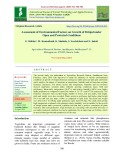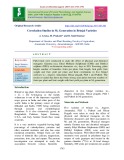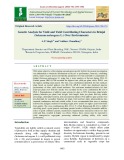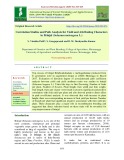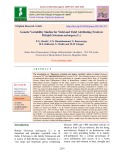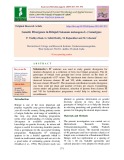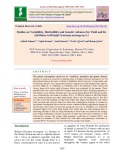
Fruit characters of Brinjal plants
-
An experiment was carried out during the year 2014-15 to 2016-17 in the polyhouse of AINP on Agricultural Acarology to estimate the losses due two spotted spider mite, Tetranychus urticae Koch (Tetranychidae: Acari). The estimated loss in brinjal due to two spotted spider mite, T. urticae on different plant growth characters like plant height, number of branches per plant, number of fruits per plant and fruit weight ranging between 8.24 to 33.65, 7.84 to 13.35, 26.94 to 64.93 and 15.29 to 81.10 per cent, respectively.
 6p
6p  caygaocaolon8
caygaocaolon8
 07-11-2020
07-11-2020
 11
11
 1
1
 Download
Download
-
The present study was undertaken with the objective to determine the nature and magnitude of association between yield and it`s component characters and their direct, indirect effects on marketable fruit yield per plant in brinjal (Solanum melongena L.).
 8p
8p  nguathienthan8
nguathienthan8
 20-10-2020
20-10-2020
 12
12
 2
2
 Download
Download
-
Genetic studies in terms of correlation and path coefficient analysis were studied for10 quantitative characters of thirty-two genotypes of brinjal (Solanum melongena L.).Total yield per plant had exhibited highly significant and positive association with marketable fruit yield per plant, fruit weight, fruit weight per plant and fruit circumference and significant association with marketable fruit yield per plant.
 6p
6p  nguaconbaynhay8
nguaconbaynhay8
 13-10-2020
13-10-2020
 17
17
 1
1
 Download
Download
-
Considering the above fact, the present study was undertaken to find out whether the shoot and fruit characters influencing the infestation rate of BSFB and also their quantitative relationships with infestation which will help to develop resistant/tolerant varieties against this pest.
 10p
10p  trinhthamhodang1215
trinhthamhodang1215
 23-09-2020
23-09-2020
 7
7
 2
2
 Download
Download
-
Thirty five accessions of brinjal were assessed for variability for nineteen characters. Highly significant differences were observed among the accessions. High phenotypic and genotypic coefficient of variation was observed for number of fruits per cluster, number of fruits per plant, fruit length, fruit width, average fruit weight, fruit yield per plant, ascorbic acid content, total phenol content, shoot and fruit borer infestation indicating the existence of wider genetic variability for these traits in the germplasm.
 6p
6p  trinhthamhodang1215
trinhthamhodang1215
 23-09-2020
23-09-2020
 14
14
 2
2
 Download
Download
-
In the present study, the components of genetic variation were studied in AN (Arka Nidhi) and SN (Singh Nath) for quantitative characters. The estimates of both additive and dominance components were significant for all the characters except days to 50 per cent flowering, fruit diameter, number of branches per plant and pedicel length. Epistasis (i) and (j+l) type was significant in all the traits except except fruit diameter (cm).
 9p
9p  kequaidan7
kequaidan7
 01-09-2020
01-09-2020
 13
13
 2
2
 Download
Download
-
Understanding the genetic variability and diversity of a crops species provides opportunity for plant breeders to develop new and improved cultivars having both farmer-preferred and breeder-preferred traits. In the present study 11 morphological characters and 16 quantitative characters were recorded from 27 advance breeding lines/varieties to identify useful alleles for future breeding. Genotypes varied considerably in plant growth and morphological characters. The overall mean of ShannonWiener diversity index (H’) value was 0.
 21p
21p  angicungduoc6
angicungduoc6
 22-07-2020
22-07-2020
 6
6
 1
1
 Download
Download
-
A study on direct and indirect effects of 12 different quantitative characters of brinjal through path analysis study on yield and its component traits had revealed that days to first flowering had the maximum positive direct effect followed by plant height, number of fruits per plant, fruit weight and node at which first flowering appear, while rest of the characters like days to 50% flowering, number of branches per plant, days to edible maturity, days to first fruiting, fruit girth and fruit length exhibited negative direct effect.
 6p
6p  angicungduoc6
angicungduoc6
 22-07-2020
22-07-2020
 7
7
 1
1
 Download
Download
-
The present study was undertaken at Agriculture Research Station, Anakkayam from February- April, 2019 with objectives to study the influence of various environmental conditions on growth of brinjal (Solanum melongena) under protected and open cultivation and to analyze the impact of variations in temperature, humidity and soil moisture on plant biometric characters. The abiotic factors like temperature, humidity and soil moisture showed significant variation under different growing conditions (open field and polyhouse). Mean daily temperature (36.
 7p
7p  angicungduoc6
angicungduoc6
 22-07-2020
22-07-2020
 16
16
 1
1
 Download
Download
-
Field trials were conducted to study the effect of physical and chemical mutagens (Gamma rays, Ethyl Methane Sulphonate (EMS) and Diethyl sulphate (DES)) on biometric characters viz., days to 50% flowering, plant height, number of branches, fruits per plant, fruit length, fruit girth, fruit weight and fruit yield per plant and their correlations in five brinjal cultivars viz., Angoor, Annamalai, Hissar pragath, PLR 1 and Putheri. The results revealed that there had been strong association between number of fruits per plant and fruit weight with fruit yield per plant in M2 generation.
 9p
9p  kethamoi6
kethamoi6
 29-06-2020
29-06-2020
 12
12
 2
2
 Download
Download
-
With prime objective of developing season/region specific hybrid, the present investigation was undertaken to obtain the information on the per se performance, heterosis, combining ability, nature of gene action and stability parameters for fruit yield and its components in brinjal (Solanum melongena L.) using line x tester analysis at Navsari during 2014-15. Female parent, JBG-10-208 recorded the highest fruit yield per plant, while, PLR-1 was the highest yielding male parent.
 12p
12p  cothumenhmong5
cothumenhmong5
 17-05-2020
17-05-2020
 17
17
 0
0
 Download
Download
-
Top crosses of brinjal Bilichandubadane × mullugaibadane produced from F1 generation were in augmented design at ZARS Shimogga in Kharif 2017. Evaluation of direction degree of associationand path coefficient analysis between yield and yield attributes traits was studies in brinjal (Solanum longena L.).
 7p
7p  chauchaungayxua4
chauchaungayxua4
 18-03-2020
18-03-2020
 16
16
 1
1
 Download
Download
-
Genetic variability studies for yield and yield attributing traits in Brinjal (Solanum melongena L.)
The investigation on ―Phenotypic evaluation and genetic variability studies in brinjal (Solanum melongena L.)‖ was undertaken during kharif season of 2017. Sixty brinjal genotypes were evaluated in randomized block design with two replications in vegetable science block, Dept. of Vegetable Science, Kittut Rani Channamma College of Horticulture, Arabhavi under the University of Horticultural Sciences, Bagalkot. In the study, analysis of variance revealed highly significant differences among genotypes for most of characters studied. The growth parameters viz.
 11p
11p  trinhthamhodang3
trinhthamhodang3
 22-02-2020
22-02-2020
 31
31
 0
0
 Download
Download
-
Mahalanobis’s D2 statistics was used to study genetic divergence for nineteen characters in a collection of forty four brinjal genotypes. The 44 genotypes of brinjal were grouped into seven clusters on the basis of relative magnitude of D2 values. The maximum inter cluster distance was observed between clusters III and VII, while minimum was recorded between clusters III and IV. The maximum contribution towards divergence was from yield per plant and number of fruits per cluster.
 4p
4p  trinhthamhodang3
trinhthamhodang3
 12-02-2020
12-02-2020
 15
15
 1
1
 Download
Download
-
The present investigation was undertaken with a view to generate genetic information on gene effects for 14 quantitative traits in brinjal through generation mean analysis. The experimental material consists of six generations, namely P1, P2, F1, F2, B1 and B2 of four crosses in brinjal viz., AB-15-07 x GJLB-4 (cross 1), JBR-14-07 x Pant Rituraj (cross 2), NSR-01 x Swarnmani Black (cross 3) and NBR-14-05 x GJB-03 (cross 4). The results indicated that the magnitude and type of gene effects differed for the same trait in different cross combinations.
 10p
10p  chauchaungayxua3
chauchaungayxua3
 07-02-2020
07-02-2020
 12
12
 0
0
 Download
Download
-
Brinjal production is threatened by bacterial wilt caused by Ralstonia solanacearum in the developing world. Evaluation in search of best performing genotypes against bacterial wilt disease and incorporating their genes in commercial cultivars is an effective attempt to the problem. Studies on genetic variability and heritability, along with degree of association between the various characters and direct effects of yield contributing characters on total yield, is of paramount significance in framing an appropriate breeding strategy.
 21p
21p  chauchaungayxua3
chauchaungayxua3
 07-02-2020
07-02-2020
 23
23
 2
2
 Download
Download
-
The present investigation carried out on “variability, heritability and genetic advance analysis in relation to selection of parental lines in brinjal (Solanum melongena L.)” at Horticultural Research Centre of Sardar Vallabhbhai Patel University of Agriculture and Technology, Meerut. The experimental material comprised of eight parental lines namely, K.S-331, DBL-24, A. Abhilomb, A. Parthibha, J.B.-6, F.Collection-2, J.B.L.-03-04 and Assury along with twenty eight F1crosses which were produced by the parents.
 7p
7p  chauchaungayxua3
chauchaungayxua3
 07-02-2020
07-02-2020
 32
32
 0
0
 Download
Download
CHỦ ĐỀ BẠN MUỐN TÌM









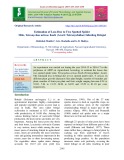
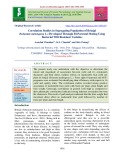
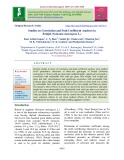

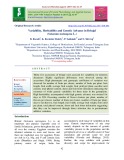
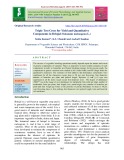
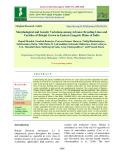
![Path co-efficient analysis for yield and yield attributing traits in Brinjal [Solanum melongena L.] Path co-efficient analysis for yield and yield attributing traits in Brinjal [Solanum melongena L.]](https://tailieu.vn/image/document/thumbnail/2020/20200722/angicungduoc6/135x160/8591595380298.jpg)
